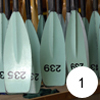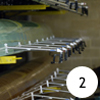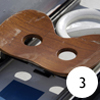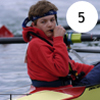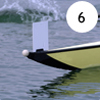Wimbleball Rowing Club. .

menu:
Rowing Boats and Basic Technique
Introduction
Rowing boats and technique varies widely between Coastal rowing, Gig rowing and Inland Rowing. Most rowing undertaken by members of Wimbleball RC is of the latter type - Inland rowing. This is usually undertaken on lakes such as at our home base at Wimbleball, or on rivers and estuaries.
The boats we use at Wimbleball are predominantly 'Fine Boats' , also know as Olympic Class boats. In addition for beginners we also have training boats available, such as the 'Virus boat' shown (below left) or else fine boats fitted with small floats for extra stability (below right).
Click links to find out about:Fine Boats | Rowing Basics | The Rowing Stroke
Fine Boats:
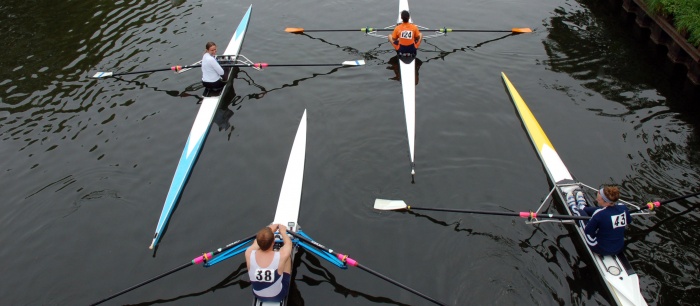
The fine boat, also known as the Olympic class boat, is the familiar racing shell that you will see rowed or sculled at inland competitions.
In 'sweep' boats, each rower has one oar (or blade). In 'sculling' boats (such as in the image above), the oarsmen use two blades. The fine boats generally have one, two, four or eight seats. The eights will always have a coxswain (cox) to steer and direct the crew, whereas a four may be coxed or coxless depending on the type of boat used.
Types of 'sweep' boats
2- (coxless pair)
2+ (coxed pair - this type of boat is rarely used)
4- (coxless four)
4+ (coxed four)
8+ (coxed eight)
Types of 'sculling' boats
1x (single)
2x (double)
4x (quad)
4x+ (coxed quad - this type of boat is generally only used by juniors)
8x+ (octuple - this type of boat is rarely used, and will be for junior use only)
Rowing Basics
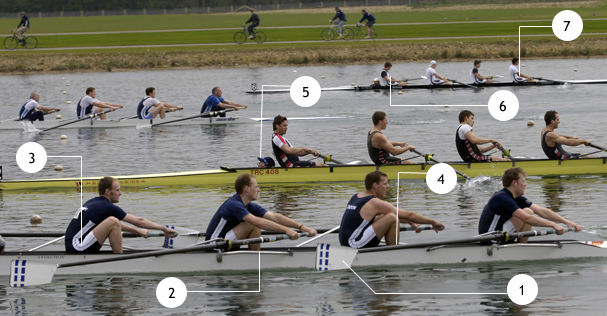
Rowing Stroke
When you learn to row, you begin with simple exercises. The following sequence of photos shows you what you will be working towards.
The Drive Phase




The Recovery Phase





 Point 1
Point 1
This is the start of the drive phase of the stroke, when the blades are placed in the water (called 'the catch') and the boat is driven forwards using the large muscle groups in the legs and body.
- The shins are vertical, the back straight and leaning forward and the body closed up on the thighs.
- All that is needed is for the hands to lift a little more in the direction of the arrow, and the blades will be fully 'locked' in the water
 Common Errors at Point 1
Common Errors at Point 1
The seat begins to move backwards faster than shoulders. This fault is known as 'bum shoving' and it causes the powerful leg drive to be weakened considerably.
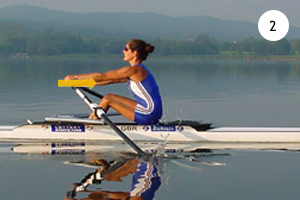
 Point 2
Point 2
It is a mistake to think that rowing is pulling with the arms, but many beginners do this.
- The legs should be doing most of the work here, with the arms relaxed and the back still straight and leaning forward.
- The hands follow the path of the arrow parallel to the boat. The feeling should be that of hanging off the blade handles.
 Common Errors at Point 2
Common Errors at Point 2
Arms pulling over the knees into an arc causing the blades to plunge too deep.

 Point 3
Point 3
Nearing the end of the drive phase the body swings back and the arms are used to maintain the momentum of the blade handles.
 Common Errors at Point 3
Common Errors at Point 3
The blade handle is pulled down (instead of along) causing the blade to lift from the water before the end of the stroke. This is called 'washing out'.

 Point 4
Point 4
The hands make a small tap downwards, to lift the blades clear of the water.
- The legs are flat down.
- The back is straight, but leaning slightly back so that the abdominal muscles feel a slight pull.
- The blade handles just brush the body when the spoon end is flat on the water.
This is the end of the drive phase and the recovery phase begins.
 Common Errors at Point 4
Common Errors at Point 4
- The rower sits too upright and the elbows droop down - the effect is to shorten the stroke.
- The rower leans too far back - which delays the recovery.
 Point 5
Point 5
At the beginning of the recovery phase, the hands move down and away, following the trajectory of the arrow.
- The arms move away from the body, which is balanced vertically, but the seat has not yet begun to move and the knees are still held down.
- The arms, shoulders and neck are relaxed. This posture aids recovery from the exertion of the stroke, and helps to keep the boat balanced in the water.
- The body then rocks over from the pelvis, with the back straight, and the knees lift, allowing the seat to move.
 Common Errors at Point 5
Common Errors at Point 5
The knees lift and get in the way of the hands, which should be moving parallel to the boat.

 Common Errors at Point 6
Common Errors at Point 6
- The hands are higher or lower than the point shown.
- The body is not leaning forward at the angle shown.
- The rower does not slow momentum before taking the catch.

 Common Errors at Point 7
Common Errors at Point 7
The body is upright and the arms are not held out long enough.
 Point 8
Point 8
The body at this point is in the catch position, moving forward until the shins are vertical and the sequence begins again.



